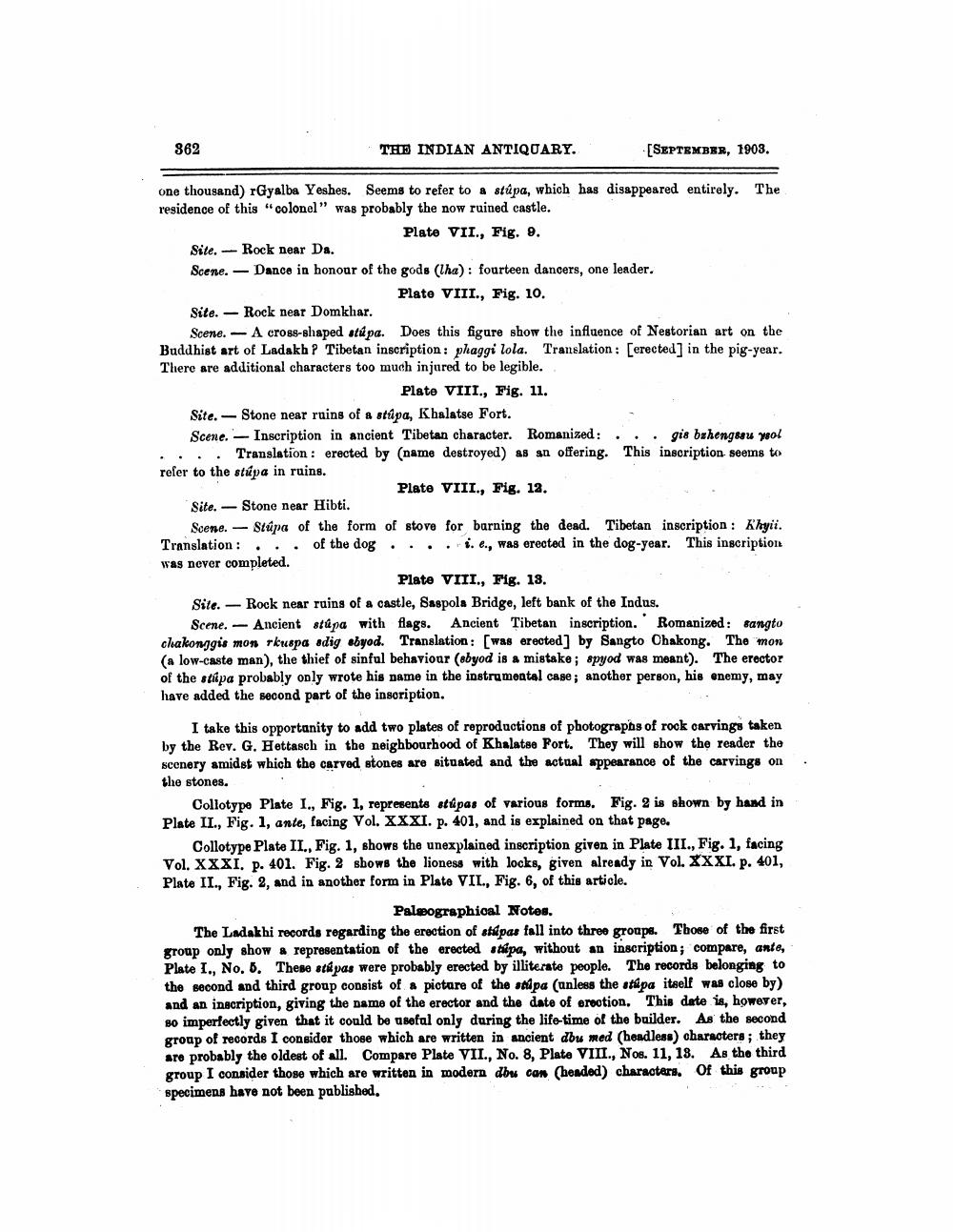________________
362
THE INDIAN ANTIQUARY.
[SEPTEMBER, 1903.
one thousand) rGyalba Yeshes. Seems to refer to a stúpa, which has disappeared entirely. The residence of this "colonel " was probably the now ruined castle.
Plate VII., Fig. 9. Site. -Rock near Da. Scene. - Dance in honour of the gods (tha): fourteen dancers, one leader.
Plate VIII., Fig. 10. Site. - Rock near Domkhar.
Scene. - A cross-shaped stúpa. Does this figure show the influence of Nestorian art on the Buddhist art of Ladakh P Tibetan inscription: phaggi lola. Translation : [erected] in the pig-year. There are additional characters too much injured to be legible.
Plate VIII., Fig. 11. Site. - Stone near ruins of a stúpa, Khalatse Fort.
Scene. -- Inscription in ancient Tibetan character. Romanized : ... gis buhengasu wol ... Translation: erected by name destroyed) as an offering. This inscription seems to refer to the stúpa in ruins.
Plate VIII., Fig. 12. Site. - Stone near Hibti.
Scene. - Stúpa of the form of stove for barning the dead. Tibetan inscription : Khyii. Translation : ... of the dog ..... e., was erected in the dog-year. This inscription was never completed.
Plate VIII., Fig. 19. Site. - Rock near ruins of a castle, Saspola Bridge, left bank of the Indus.
Scene. - Ancient stúpa with flags. Ancient Tibetan inscription. Romanized : sangto chakonggis mon riuspa odig sbyod. Translation: [was erected] by Sangto Chakong. The mon (a low-caste man), the thief of sinful behaviour (sbyod is a mistake; spyod was meant). The erector of the stílpa probably only wrote his name in the instrumental case; another person, his enemy, may have added the second part of the insoription.
.
I take this opportanity to add two plates of reproductions of photographs of rock carvings taken by the Rev. G. Hettasch in the neighbourhood of Khalatse Port. They will show the reader the scenery amidst which the carved stones are situated and the actual appearance of the carvings on the stones.
Collotype Plate I., Fig. 1, represents stúpas of various forms. Fig. 2 is shown by hand in Plate II., Fig. 1, ante, facing Vol. XXXI. p. 401, and is explained on that page.
Collotype Plate II., Fig. 1, shows the unexplained inscription given in Plate III., Fig. 1, facing Vol. XXXI. p. 401. Fig. 2 shows the lioness with locks, given already in Vol. XXXI. p. 401, Plate II., Fig. 2, and in another form in Plate VIL, Fig. 6, of this article.
Paleographical Notes. The Ladakhi records regarding the erection of stúpas fall into three groupe. Those of the first group only show a representation of the erected stipa, without an inscription; compare, ante, Plate I., No. 6. These stk pas were probably erected by illiterate people. The records belonging to the second and third group consist of a pictare of the snipa (unless the stúpa itself was close by) and an inscription, giving the name of the erector and the date of erootion. This date is, however, so imperfectly given that it could be useful only during the life-time of the builder. As the second group of records I consider those which are written in ancient du med (headless) characters; they are probably the oldest of all. Compare Plate VII, No. 8, Plate VIII., Nos. 11, 18. As the third group I consider those which are written in modern dbu con (headed) characters. Of this group specimens have not been published,




